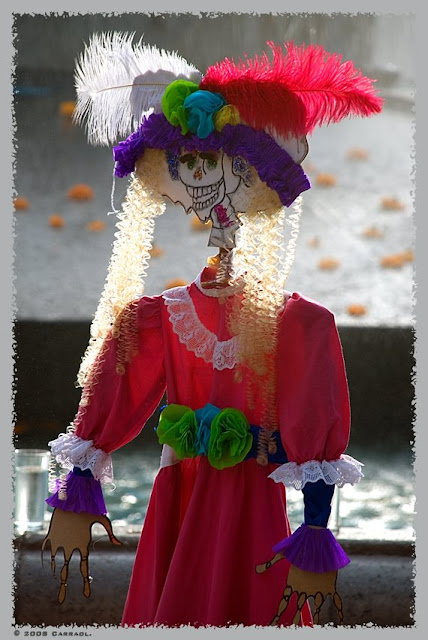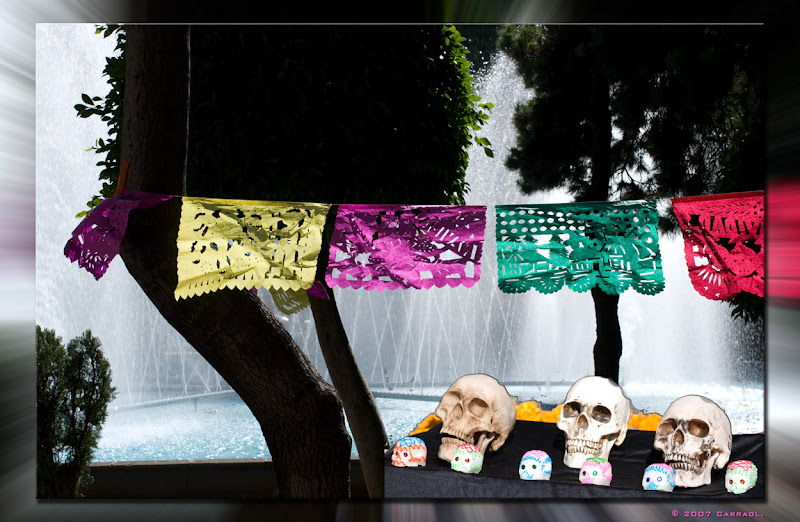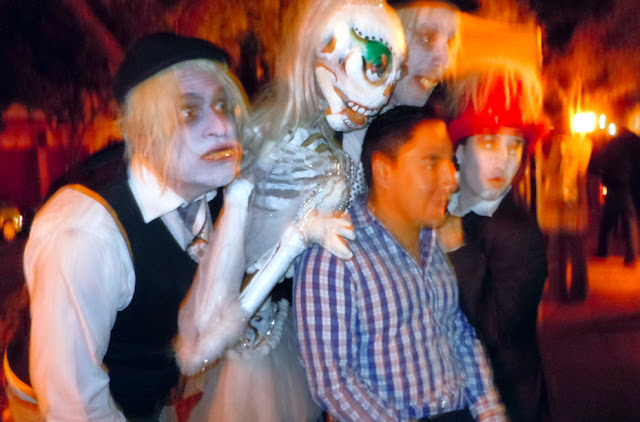The Magic of the Cities.
Zen promotes the rediscovery of the obvious, which is so often lost in its familiarity and simplicity. It sees the miraculous in the common and magic in our everyday surroundings. When we are not rushed, and our minds are unclouded by conceptualizations, a veil will sometimes drop, introducing the viewer to a world unseen since childhood. ~ John Greer
Friday, November 6, 2015
Tuesday, November 3, 2015
Day of The Dead
Sunday, November 4, 2012
Day of The Dead in Mexico City
 |
| Todo el año es día de muertos en México / All year is Day of the Dead in Mexico |
 |
| Offerings |
Bread of the Dead because of the extension of the City, one must visit the Capital for at least two continuous years during the season of Day of the Dead, to have a more profound vision of the changes that take place in it’s inhabitants when they start preparing to celebrate this tradition, so closely tied to the soul of Mexicans.
To be born and to die is one of the dualities faced by human beings and everything that exists. This duality is the key to the Mexican idiosyncrasy, manifested in the pre-Cortez epoch and routed among the centuries in a mix of pre-Hispanic and religious beliefs, of humor and mysticism, of sadness and joy.
Altar Museum Estudio Diego Rivera like the small towns of the provinces, the majority of the residents in Mexico City prepare with anticipation to celebrate with dignity the return of the souls of the dead. In the Capital the offerings are placed in museums and galleries entrusting the work to artists that interpret different subjects or motives, in creating truly artistic designs to later expose them to an array of aromas and colors in which the flower of the season – the cempasuchitl – is the prevailing one.
It is difficult to calculate the amount of craftsmanship that is sold at different prices in Mexico City; this shows that the industry that generates the Day of the Dead is one of the most important affecting the year’s economy of the city, and at the same time demonstrates that this tradition is more alive than ever.
Paper mache calaca in what corresponds to the festive activity, besides eating the chocolate and sugar skeletons with one’s name on it, children, even adults buy toys with images of an enthusiastic skeleton made of paper mache, and jointed skeletons which dance when you pull on a string. Very few stay away from the funeral procession consisting of paper dolls with heads made of garbanzo, which move by the means of a thread, making the head come out of the coffin. The craftsman takes advantage of the opportunity to write special messages on the coffin.
From the bilingual book “Through the Eyes of the Soul Day of the Dead In Mexico - Mexico City, Mixquic and Morelos”. For information of books about this tradition, written by Mary J. Andrade, visit www.dayofthedead.com
Tuesday, November 2, 2010
The Day of The Dead
 |
Monday, November 2, 2009
Day of The Dead / El Día de los Muertos

Ver.2

Scholars trace the origins of the modern holiday to indigenous observances dating back thousands of years, and to an Aztec festival dedicated to a goddess called Mictecacihuatl.
Similar holidays are celebrated in many parts of the world; for example, it's a public holiday (Dia de Finados) in Brazil, where many Brazilians celebrate by visiting cemeteries and churches. In Spain, there are festivals and parades, and at the end of the day, people gather at cemeteries and pray for their loved ones who have died. Similar observances occur elsewhere in Europe and in the Philippines, and similarly-themed celebrations appear in many Asian and African cultures.
One of the worst forms of mental suffering is boredom, not knowing what to do with oneself and one's life. Even if man had no monetary, or any other reward, he would be eager to spend his energy in some meaningful way because he could not stand the boredom which inactivity produces.
- Erich Fromm
Sunday, November 2, 2008
Dia de Muertos

Las Calacas


Tequila for The Dead

The Day of the Dead (Día de los Muertos in Spanish) is a holiday celebrated mainly in Mexico and by people of Mexican heritage (and others) living in the United States and Canada. The holiday focuses on gatherings of family and friends to pray for and remember friends and relatives who have died. The celebration occurs on the 1st and 2nd of November, in connection with the Catholic holy days of All Saints' Day and All Souls' Day which take place on those days. Traditions include building private altars honoring the deceased, using sugar skulls, marigolds, and the favorite foods and beverages of the departed, and visiting graves with these as gifts. Observance of the holiday in Mexican-American communities in the United States has become more important and widespread as the community grows numerically and economically. [Wiki.]
music+image
Gracias por su visita / Thanks for visiting.
Saturday, November 1, 2008
November 2008 Theme Day: Books

Click here to view thumbnails for all participants.
An altar on a bookstore shop window at Roma borough.
The Day of the Dead (Día de los Muertos in Spanish) is a holiday celebrated mainly in Mexico and by people of Mexican heritage (and others) living in the United States and Canada. The holiday focuses on gatherings of family and friends to pray for and remember friends and relatives who have died. The celebration occurs on the 1st and 2nd of November, in connection with the Catholic holy days of All Saints' Day and All Souls' Day which take place on those days. Traditions include building private altars honoring the deceased, using sugar skulls, marigolds, and the favorite foods and beverages of the departed, and visiting graves with these as gifts. Observance of the holiday in Mexican-American communities in the United States has become more important and widespread as the community grows numerically and economically.
Similar holidays are celebrated in many parts of the world; for example, it is a public holiday in Brazil, where many Brazilians celebrate by visiting cemeteries and churches. In Spain, there are festivals and parades, and at the end of the day, people gather at cemeteries and pray to their loved ones who have died. Similar observances occur elsewhere in Europe and in the Philippines, and similarly-themed celebrations appear in many Asian and African cultures. [Wiki.]
music+image
Gracias por su visita / Thanks for visiting.
Friday, November 2, 2007
Day of The Dead

The offerings placed on the altar for Dia de los Muertos usually consist of a wash bowl, basin, razors, soap and other items the traveling spirit can use to clean-up after the journey. Pictures of the deceased are also placed on the altar as well as personal belongings for each person and any other offerings the deceased may enjoy such as a pack of cigarettes or a bottle of tequila. Candles are used to help light the way for the spirits as well as other decorative items such as papel picado (tissue paper cut-outs) wreaths, crosses and flowers. Certain Dia de los Muertos dishes are also placed on the altar to help feed and nourish the traveling souls. Some of these offerings also double as the four main elements of nature — earth, wind, water, and fire. These are represented by movable or light-weight items such as tissue paper cut-outs (wind,) a bowl of water, candles (fire) and food (crops, earth.) Chelsie Kenyon.
Gracias por su visita / Thanks for visiting.
Wednesday, October 31, 2007
Ofrenda / Offering

'Offering in the window of a library'
The offerings placed on the altar for Dia de los Muertos usually consist of a wash bowl, basin, razors, soap and other items the traveling spirit can use to clean-up after the journey. Pictures of the deceased are also placed on the altar as well as personal belongings for each person and any other offerings the deceased may enjoy such as a pack of cigarettes or a bottle of tequila. Candles are used to help light the way for the spirits as well as other decorative items such as papel picado (tissue paper cut-outs) wreaths, crosses and flowers. Certain Dia de los Muertos dishes are also placed on the altar to help feed and nourish the traveling souls. Some of these offerings also double as the four main elements of nature — earth, wind, water, and fire. These are represented by movable or light-weight items such as tissue paper cut-outs (wind,) a bowl of water, candles (fire) and food (crops, earth.) Chelsie Kenyon.
Gracias por su visita / Thanks for visiting.






















